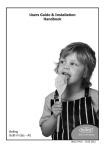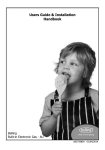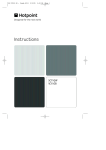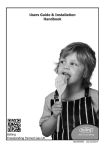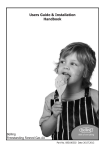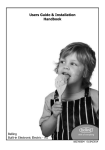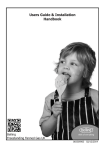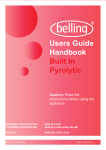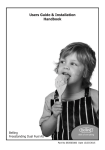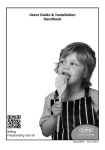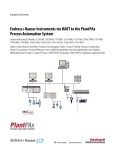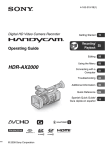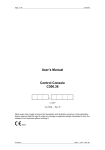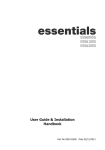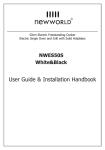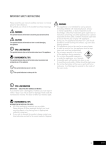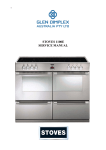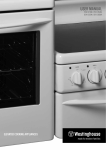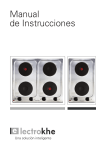Download User Manual
Transcript
Users Guide & Installation Handbook Belling Built-in Fan Gas - AU 083383300 19/02/2015 CONTENTS & OUR WARRANTY CONTENTS Important Notice • SAFETY • USING THE PRODUCT • COOKING GUIDES • CLEANING • INSTALLATION INSTRUCTIONS • TECHNICAL DATA • WIRING DIAGRAM • CUSTOMER CARE Please note there is a cooling fan fitted to this appliance. It is an integral part of its safety and functionality. When the appliance is installed care must be taken that the cooling fans performance is not impeded by any objects coming into contact with it. (Installation pipes, leads etc) Care must also be taken that there is sufficient air flow at the rear of the appliance for the cooling fan to run at its optimum efficiency, (particularly built in appliances) see clearance dimensions in the installation section of the booklet. During use the appliance must never be disconnected from the mains supply as this will seriously affect the safety and performance of the appliance, particularly in relation to surface temperatures becoming hot and gas operated parts not working efficiently. The cooling fan is designed to run on after the control knob has been switched off to keep the front of the appliance and the controls cool until the appliance has naturally cooled itself. INTRODUCTION Should you need it . . . . Inside the paperwork which has come with this appliance, there is a leaflet and card explaining the terms of our warranty and guarantee. Simply fill in the details on the card and post it off, this will register your appliance or register online. Glen Dimplex Australia PTY LTD 1/21 Lionel Road Mount Waverley Victoria 3149 Australia Ph: 1300 556 816 Fx: 1800 058 900 Glen Dimplex New Zealand Pty 38 Harris Road, East Tamaki Auckland New Zealand Ph: 09 274 8265 Fx: 09 274 8472 If your appliance is covered by the warranty and guarantee, you will not be billed for work undertaken should your appliance be faulty, terms and conditions do apply, so please read through the literature carefully. Please ensure that you have available your appliances model number and serial number, there is a space at the back of this book for recording that information. SAFETY BEFORE USING THE PRODUCT Make sure that you have removed all packaging and wrapping. Some of the items inside this appliance may have additional wrapping. It is advised that you turn the ovens and/ or grill on for a short while. This will burn off any residues left from manufacturing. There may be a smell which accompanies this process - but this is nothing to worry about and is harmless. It is recommended that you wash the oven shelves, grill pan and grill pan trivet before their first use in hot soapy water. This will remove the protective oil coating. Please note:- these safety warnings cover both gas and electric products. GENERAL WARNING! - The appliance and its accessible parts become hot during use. Care should be taken to avoid touching heating elements. Children less than 8 years of age shall be kept away unless continously supervised. This appliance can be used by children aged from 8 years and above and persons with reduced physical sensory or mental capabilities or lack of experience and knowledge if they have been given supervision or instruction concerning the use of the appliance in a safe way and understand the hazards involved. Children shall not play with the appliance. Cleaning and user maintenance shall not be made by children without supervision. WARNING! Unattended cooking on a hob with fat or oil can be dangerous and may result in fire. NEVER try to extinguish a fire with water, but switch off the appliance and then cover the flame with a lid or damp cloth. WARNING! - Danger of fire: Do not store items on the cooking surfaces. WARNING! - Servicing should be carried out SAFETY only by authorised personnel. • The appliance must never be disconnected from the mains supply during use, as this will seriously affect the safety and performance, particularly in relation to surface temperatures becoming hot and gas operated parts not working efficiently. The cooling fan is designed to run on after the control knob has been switched off. • Do not spray aerosols in the vicinity of this appliance while it is in operation. • Do not store or use flammable liquids or items in the vicinity of this appliance. • Do not modify this appliance. CAUTION: The use of a gas cooking appliance results in the production of heat, moisture and products of combustion in the room in which it is installed. Ensure that the kitchen is well ventilated especially when the appliance is in use: keep natural ventilation holes open or install a mechanical ventilation device (mechanical extractor hood). Prolonged intensive use of the appliance may call for additional ventilation, for example opening of a window, or more effective ventilation, for example increasing the level of mechanical ventilation where present. SAFETY WARNING! Do not operate the appliance without the glass panel correctly fitted. WARNING! Never put items directly on the base of an electric oven or cover the oven base with foil, as this can cause the base element to overheat. WARNING! The top element gets extremely hot when in use, so take extra care to avoid touching it. WARNING! Do not modify the outer panels of this appliance in any way. WARNING! This appliance must be earthed. WARNING! - Ensure that the appliance is allowed to cool and is switched off before replacing the lamp to avoid the possibility of electric shock WARNING! - Do not use harsh abrasive cleaners or sharp metal scrapers to clean the oven door glass since they can scratch the surface, which may well result in shattering of the glass. GAS WARNING! If you smell gas: Do not try to light any appliance. Do not touch any electrical switch. Contact your local gas supplier immediately. CAUTION: This appliance is for cooking purposes only. It must not be used for other purposes, for example SAFETY room heating. OVEN / GRILL Do • Always take care when removing food from the oven as the area around the cavity may be hot. • • • Always use oven gloves when handling any utensils that have been in the oven as they will be hot. Always make sure that the oven shelves are resting in the correct position between two runners. Do not place the oven shelves on top of the highest runner, as this is not stable and can lead to spillage or injury. Always use the programmer/timer (if fitted) if you are leaving the oven unattended - this reduces the risk of food burning. Do Not • Never place items on the door while it is open. • Never wrap foil around the oven shelves or allow foil to block the flue. • Never drape tea towels near the oven while it is on; this will cause a fire hazard. • Never pull heavy items, such as turkeys or large joints of meat, out from the oven on the shelf, as they may overbalance and fall. Never use this appliance to heat anything other than food items and do not use it for heating the room. USING THE GRILL - ELECTRIC Caution: Accessible parts may be hot when the grill is used - young children should be kept away. After placing the grill pan in position, the door can be partially closed to the arrest position as shown below. If cleaning the grill pan when it is hot, use oven gloves to move it. Food for grilling should be positioned centrally on the trivet or the grill pan base. NEVER OPERATE THE GRILL WITH THE DOOR CLOSED Using the grill Important: The door must be open when the grill is used. Open the door. Turn the grill control knob to the grill symbol position. For best grilling results, we recommend that you preheat the grill for about 3 minutes. Push the grill pan towards the back of the shelf, to position it under the grill. The speed of grilling can be controlled by selecting a higher or lower shelf position. For toasting, and for grilling foods such as bacon, sausages or steaks, use a higher shelf position. For thicker foods such as chops or chicken joint pieces, use a lower shelf position. The grill trivet, inside the grill pan, can be inverted to give a high or low position, or it may be removed. The HIGH trivet position is suitable for toasting bread. The LOW trivet position is suitable for grilling all types of meat & fish. With the grill trivet removed the food is placed directly on the base of the grill pan - eg: when cooking whole fish or browning dishes such as cauliflower cheese. To turn off, turn the control knob to the OFF position. Aluminium foil Using aluminium foil to cover the grill pan, or putting items wrapped in foil under the grill creates a fire hazard. The cooling fan When the grill is switched on, the cooling fan comes on to keep the fascia and control knobs cool during grilling. The fan will continue to operate for a pre-set time period after the grill has been turned off. USING THE MULTI-FUNCTION OVEN SWITCH - (M-FOS) Position Symbol Function 0 OFF 1 Conventional cooking 2 Conventional cooking with light 3 Fanned cooking with light 4 Fanned cooking 5 Defrost 6 Light Notes: The control knob may be turned in either direction from any set position. • • • • At positions 1 - 4 inclusive a solenoid valve is electrically opened to allow gas to pass from the oven control to the oven burner. After turning off the oven control knob, always return the multi-function oven switch control knob to the OFF position. This will de-energize / close the solenoid valve. At positions 1 - 4 inclusive, the cooling fan is electrically powered. When the multi-function oven switch control knob is returned to the OFF position, the cooling fan will continue to operate for a pre-set time period. USING THE MAIN OVEN - CONVENTIONAL GAS USING THE MAIN OVEN For main oven conventional cooking, turn the multi-function oven switch (M-FOS) control knob to position 1 . The temperature at the oven base is suitable for cooking baked vegetables, baked fruit, milk pudding etc, and for warming bread rolls, soup, coffee, or ovenproof plates and dishes. Push in and turn the oven control knob anti-clockwise to the maximum temperature position. Continue to hold the control knob in for up to 15 seconds then release. If you find over a period of time, the oven becomes hotter when used at a particular temperature, the thermostat may need to be replaced. If the burner fails to ignite within this time, release the control knob, open the door and wait for 1 minute before attempting to re-ignite. Notes: As part of the cooking process, hot air is expelled through a vent at the top of the oven(s). When opening the oven door, care should be taken to avoid any possible contact with potentially hot air, since this may cause discomfort to people with sensitive skin. To open the door, we recommend that you hold the underside of the oven door handle. After satisfactory ignition, continue to hold in the control knob for a further 5-10 seconds, then turn the control knob to the desired temperature setting. To turn off, turn the oven control knob and the M-FOS control knob to their OFF positions. Preheating Preheat the main oven for 15 minutes. If you are not preheating the oven, the cooking times in the baking guides may need to be extended, as they are based on a preheated oven. The oven must be preheated when reheating frozen or chilled foods, and we recommend preheating for yeast mixtures, batters, soufflés and whisked sponges. Put the oven shelves in the position required before preheating the oven. Zones of heat The temperature at the centre of the oven corresponds with the selected temperature setting and is higher towards the top of the oven and lower towards the oven base. These zones of heat can be useful as different dishes requiring different temperatures can be cooked at the same time, when more than one shelf is used. Oven light Turn M-FOS control knob to position 2 to assist viewing food without altering the conventional gas cooking mode. OVEN FURNITURE Baking tray and roasting tins For best cooked results and even browning, the maximum size baking trays and roasting tins that should be used are as follows; Baking tray 350mm x 300mm Roasting tin 350mm x 300mm Position baking trays and roasting tins on the middle of the shelves, and leave at least 80mm (approx 3¼”) between shelves positions, to allow for circulation of heat. The two full - width enamelled trays provided should be used as a grill pan and a drip tray. To use as a drip tray, we recommend fitting directly on to telescopic runner 1 (bottom runner). The drip tray may USING THE MAIN OVEN - CONVENTIONAL GAS be left on runner 1, whilst baking trays are used on other runners e.g. - runner 3 and runner 7. • DO NOT use the full-width trays as baking trays for cakes. • DO NOT leave the grill pan in position whilst cooking, as this will prevent the natural circulation of heat. Food Oven shelves Extra shelves may be ordered from your local supplier. The oven shelf must be positioned with the up-stand at the rear of the oven and facing upwards. Recommended temperature Suggested shelf position (°C) Approximate cooking time (preheated oven) Scones 230 middle - top 10 - 15 mins Meringues 120 bottom 2 - 3 hours 190 190 215 180 middle middle middle middle 180 170 170 150 middle middle middle middle - top 20 - 30 mins 1 - 1¼ hours 1 - 1¼ hours 2½ - 3 hours 150 or 160 bottom - middle 170 middle - bottom depending on recipe 2 - 2½ hours Pastry Rough Puff Flaky/Puff Shortcrust Flan 230 215 215 215 middle middle middle middle - top top top top Cooking time depends on recipe and type of filling Biscuits Nut brownies Brandy snaps Flapjacks Gingernuts 200 185 185 185 middle middle middle middle - top top top top 25 10 20 10 Cakes Small cakes Whisked sponge Swiss roll Victoria sandwich (2 x 180mm/7”) Genoese sponge Madeira (180mm/7”) Gingerbread Semi rich fruit cake (205mm/8”) Christmas cake (205mm/8”) Dundee cake (205mm/8”) - top top top top 15 20 10 20 - - 25 25 12 30 35 12 25 20 mins mins mins mins mins mins mins mins *Shelf positions are counted from the bottom runner upwards. Bottom shelf position is runner 1 (telescopic). Top shelf is runner 8. USING THE MAIN OVEN - FANNED GAS USING THE MAIN OVEN cooked within the same period of time. Ensure the oven shelves are positioned into the selected runner positions. Close the door. When batch baking foods that will rise during cooking – e.g. bread – always ensure that enough space has been left between the shelves to allow for the rise. For main oven fanned gas cooking, turn the M-FOS oven switch control knob to position 4 Push in and turn the oven / grill control knob anti-clockwise to the maximum temperature position. Continue to hold the control knob in for up to 15 seconds then release. If the burner fails to ignite within this time, release the control knob, open the door and wait for 1 minute before attempting to re-ignite. After satisfactory igntion, continue to hold in the control knob for a further 5-10 seconds, then turn the control knob to the desired temperature setting. To turn off, turn the oven / grill control knob and the M-FOS control knob to their OFF positions. Preheating Preheat the main oven for 15 minutes. If you are not preheating the oven, the cooking times in the baking guides may need to be extended, as they are based on a preheated oven. The oven must be preheated when reheating frozen or chilled foods, and we recommend preheating for yeast mixtures, batters, soufflés and whisked sponges. Put the oven shelves in the position required before preheating the oven. Cooking with a fanned oven There are no zones of heat in a fan oven as the convection fan at the back of the oven ensures a more even temperature throughout the oven. This makes it ideal for batch baking – e.g. when preparing for a party - as all of the items will be Notes: As part of the cooking process, hot air is expelled through a vent at the top of the oven(s). When opening the oven door, care should be taken to avoid any possible contact with potentially hot air, since this may cause discomfort to people with sensitive skin. To open the door, we recommend that you hold the underside of the oven door handle. Oven light Turn M-FOS control knob to position 3 to assist viewing food without altering the fanned gas cooking mode. OVEN FURNITURE Baking tray and roasting tins For best cooked results and even browning, the maximum size baking trays and roasting tins that should be used are as follows; Baking tray 350mm x 300mm Roasting tin 350mm x 300mm Position baking trays and roasting tins on the middle of the shelves, and leave at least 80mm (approx 3¼”) between shelves, to allow for circulation of heat. The two full - width enamelled trays provided should be used as a grill pan and a drip tray. To use as a drip tray, we recommend fitting directly on to telescopic runner 1 (bottom runner). The drip tray may be left on runner 1, whilst baking trays are used on other runners e.g. runner 3 and runner 7 • DO NOT use the full-width trays as baking trays for cakes. • DO NOT leave the grill pan in position USING USING THETHE MAIN MAIN OVEN OVEN - CONVENTIONAL - FANNED GASGAS whilst cooking, as this will prevent the natural circulation of heat. Oven shelves Extra shelves may be ordered from your local supplier. The oven shelf must be positioned with the up-stand at the rear of the oven and facing upwards. Food Main Oven Baking Guide The following is intended as a guide and experience may show some slight variation to be necessary to meet individual requirements. Ovens were preheated for 15 minutes before testing. Fanned gas oven Recommended temperature (° C) Oven Shelf position Time (minutes) Hard - individual 120 Any 90-180 Soft-Individual 190 Any 15-20 Pavlova - 6 egg 130 Any 75 Meringues Biscuits Rolled 190 Any 10-15 Spooned 190 - 200 Any 12-15 Shortbread Biscuits 170 Any 30-35 Patty cakes 190 - 200 Any 15-20 Cakes Sponge - 4 egg 190 Any 20-30 Plain Butter Cake 190 Any 25-40 Rich Fruit Cake 150 Any 180 230 - 240 Any 10-15 Cornish Pasties # 210 then 190 Any 10 then 30 Custard Tart # 230 then 190 Any 10 then 35 220 Any 25-30 220 Any 25-30 Scones Plain or fruit Pastry - Shortcrust Pastry Choux Cream Puffs Yeast Goods Bread * Shelf positions are counted from the bottom runner up. Bottom shelf position is runner 1 (telescopic). Top shelf position is runner 8. #Turn down temperature shown. USING USING THE THE MAIN MAIN OVEN OVEN - CONVENTIONAL - GENERAL INFO GAS SLOW COOKING • Make sure that frozen foods are thoroughly thawed before cooking. Do not slow cook joints of meat or poultry weighing more than 2¼kg/4½lb. Always use the top half of the oven for slow cooking. Do not use soft tub margarine for rich fruit cakes, unless specified in the recipe. • Always use the correct size and shape of tin for the recipe quantities. Slow cooking times will be about three times as long as conventional cooking times. In conventional cooking mode, if 2 trays of scones were to be baked simultaneously, the upper tray would be ready for removal before the lower tray was complete. The lower tray should then replace the upper tray. Cooking times and temperatures The temperature settings and times given in the baking guide are based on dishes made with block margarine. If soft tub margarine is used it may be necessary to reduce the temperature setting. Roast turkey Roasting turkey involves cooking two different types of meat - the delicate light breast meat, which must not be allowed to dry out, and the darker leg meat, which takes longer to cook. The turkey must be roasted long enough for the legs to cook, so frequent basting is necessary. The breast meat can be covered once browned. • Always make sure that the turkey is completely thawed and that the giblets are removed before cooking. • Turkey should be roasted at 190°C 200°C for 20 minutes per 450g (1lb), plus 20 minutes, unless packaging advises otherwise. • The turkey can be open roasted, breast side down, for half of the cook time, and then turned over for the remainder of the cooking time. • If the turkey is stuffed, add 5 minutes per 450g (1lb) to the cooking time. • If roasting turkey covered with foil, add 5 minutes per 450g (1lb) to the cooking time. Traditional fruit cakes It is necessary to test the cake before removal from the oven. Use a fine warmed skewer inserted into the centre of the cake. If the skewer comes out clean, then the cake is cooked. • Do not attempt to make Christmas cakes larger than the oven can cope with, you should allow at least 25mm (1 inch) space between the oven walls and the tin. • Always follow the temperatures recommended in the recipe. • To protect a very rich fruit cake during cooking, tie 2 layers of brown paper around the tin. • We recommend that the cake tin is not stood on layers of brown paper, as this can hinder effective circulation of air. To test if the turkey is cooked, push a fine skewer into the thickest part of the thigh. If the juices run clear, the turkey is cooked. If the juices are still pink, the turkey will need a longer cooking time. Roasting guide The times given in the roasting guide are only approximate, because the size and age of the bird will influence cooking times as will the shape of a joint and the USING USING THE THE MAIN MAIN OVEN OVEN - CONVENTIONAL - GENERAL INFO GAS proportion of the bone. • Frozen meat should be thoroughly thawed before cooking. For large joints it is advisable to thaw over night. Position the oven shelf so that the meat or poultry is in the centre of the oven. • It is recommended that the appliance is cleaned after open roasting. Frozen poultry should be thoroughly thawed before cooking. The time required depends on the size of the bird - eg; a large turkey may take up to 48 hours to thaw. Use of a trivet with a roasting tin will reduce fat splashing and will help to keep the oven interior clean. Alternatively, to help reduce fat splashing, potatoes or other vegetables can be roasted around the meat/poultry. For roasting joints of meat or poultry, and for pot roasts preheat the oven to 215°C and cook for 30 minutes, then adjust the oven control to 125°C for the remainder of the cooking time. Notes: • When cooking stuffed meat or poultry calculate the cooking time from the total weight of the meat plus the stuffing. • For joints cooked in foil or covered roasters, and for lidded casseroles, add 5 minutes per 450g (1lb) to the calculated cooking time. • Smaller joints weighing less than 1.25kg (2½lb) may require 5 minutes per 450g (1lb) extra cooking time. Cook in oven at 190°C - 200°C Approximate Cooking Time (preheated oven) Beef Rare Medium Well done 20 minutes per 450g (1lb), plus 20 minutes 25 minutes per 450g (1lb), plus 25 minutes 30 minutes per 450g (1lb), plus 30 minutes Lamb Medium Well Done 25 minutes per 450g (1lb), plus 25 minutes 30 minutes per 450g (1lb), plus 30 minutes Pork 35 minutes per 450g (1lb), plus 35 minutes Poultry 20 minutes per 450g (1lb), plus 20 minutes HANDLING BAKING PROBLEMS Problem Causes Uneven cooking • Oven not preheated adequately • Preheat oven to instructions • Incorrect shelf position • Refer to oven cooking guide • Oven tray too large • Try other trays or dishes • Trays not in centre of shelf • Put trays in centre of shelf • Air flow in oven uneven • Turn food during cooking • Oven not preheated • Preheat until indicator light goes off for electric & at least 15 minutes for gas • Aluminum foil in oven • Remove foil • Baking tins too large for recipe • Use correct size tins • Baking tins not evenly spaced • Place baking tins so that there is at least 3 cms between tins and oven walls • Food not evenly sized or placed on trays • Make food same size and shape and spread evenly on trays • Food placed too close to top of oven • Place food in middle or on a lower shelf • Baking temperature too high • Lower temperature • Baking tins too large for recipe • Use correct size tins • Food too low in oven • Cook two shelves higher • Oven door opened too frequently during cooking • Do not open door until at least three quarters (3/4) of the way through cooking time or switch on oven light and view through door glass Baked products too brown on top Baked products too brown on bottom What to do HANDLING BAKING PROBLEMS Problem Causes Cakes have cracked thick crust • Baking temperature too high • Lower temperature • Food too high in oven • Cook on lower shelf • Cake batter over mixed • Mix just long enough to combine ingredients • Pan too deep • Check size of pan and use recommended size • Baking temperature too low • Raise temperature • Food too low or high in oven • Cook on higher shelf for gas or lower shelf for electric • Baking time too short • Increase cooking time • Incorrect tin size • Use correct size tin • Baking temperature too low • Raise temperature • Food too low in oven • Cook on higher shelf • Baking time too short • Increase cooking time • Measurement of ingredients is wrong • Check recipe • Door opened too early • Do not open door until at least three quarters (3/4) of the way through cooking time or switch on oven light and view through door glass Crusts too thick • Incorrect ingredients • Check recipe Meat and potatoes not browning in fan oven • Poor circulation • Put food onto a rack to allow air to circulate properly. Juices running out of meat • Meat pierced • Do not pierce meat with fork but turn with tongs Baking products are pale, flat and undercooked Cakes fallen in centre What to do RECOMMENDATIONS AND GOOD PRACTICES • After igniting the oven burner, always turn the oven burner control knob to the maximum control knob setting and then turn down to the desired temperature setting. • After preheating the oven for 15 minutes at the selected temperature, open the door and enter the food as quickly as possible to minimise heat losses. • Close oven door gently so as not to disturb the position of foods or cause unnecessary disturbance to the oven flame. • Whenever possible use the oven light to assist viewing the cooking progress, rather than opening the door to view food. • Do not leave the oven light on continuously during the cooking process, this wastes energy and costs you more. • Certain dishes can leave lingering odours in an oven, which can taint the taste of the next food cooked or baked. To prevent this, after cooking a particularly odorous dish, e.g. fatty lamb, allow the oven to cool, open the oven door, wipe up any obvious spills and splashes from the oven interior, then set the M-FOS control knob to position 5 and allow the fan to operate for awhile, to help force out the odours. • Always remember to turn the M-FOS control knob to OFF after use. Do not waste energy. USING THE CLOCK PROGRAMMER-GAS (IF FITTED) The alternative programmers There are two types of programmer covered in this section - push button & touch control. Both programmers have the same symbol variants & functions but may vary in their method of operation. THE PUSH BUTTON PROGRAMMER The ‘function’ button in the centre is used for setting the minute minder and setting up the semi-automatic cooking. See below for details. To set the time of day When the power is turned on to the appliance, the time of day starts from 0.00. Press and release the (minus) and (plus) buttons simultaneously. Set the time of day, eg 2.00 with the and buttons while the ‘dot’ between the hours and minutes is flashing. To select an alarm tone Press and hold the (minus) button to listen to the first tone. Release the button and press it again to listen to the second tone, etc. Releasing the button after the tone has sounded will automatically select that tone. Setting the minute minder Press and release the function button. The minute minder bell symbol will appear and flash on the display. Use the plus and minus buttons to set the required alarm time. After setting, the display will revert to show the time of day and the bell symbol will stop flashing. Pressing the function button will display the minutes remaining. If the time has counted down to the last minute, the remaining seconds are shown. The tone will sound at the end of the time set. To cancel the tone, press any button. Semi-automatic cooking This clock function can be used when you have started cooking food in the oven and want to set the time for the oven to switch off. This can be done in 2 ways, either, 1. Press and release the function button twice. The display will flash the letters ‘dur’ (duration) and the ‘A’ (auto) symbol. Use the plus and minus buttons to set the display to show the length of cooking time required (eg, 2 hours) or 2. Press and release the function button 3 times. The display will flash the word ‘End’ (end of cooking time) and the ‘A’ (auto) symbol. Use the plus and minus buttons to show the end of cooking time. After setting, the display will revert to show the time of day and the oven and auto symbols will be shown in the display. The function button can be pressed and released twice to show how much cooking time remains on the clock or 3 times to show the end time. At the end of the cooking time, the alarm will sound and the oven will automatically switch off. To USING THE CLOCK PROGRAMMER-GAS (IF FITTED) switch off the alarm, press any button. If you wish to cancel the remaining cooking time on the clock before the alarm sounds, press the minus button until the display returns to 0.00. NOTE - the minute minder function can be used independently from other timer functions; e.g. it is still possible to use the minute minder facility during a semi-automatic cooking function. When both programs are running simultaneously, both the semi-automatic indicator ‘A’ and oven symbol will be displayed alongside the minute minder bell indicator in the time of day display. THE TOUCH CONTROL PROGRAMMER Setting the time of day (24 hour clock) Press and release the function touch control until ‘:’ and the time of day icon start flashing. Set the current time using the minus and plus controls. After 7 seconds the time of day icon disappears and the ‘:’ icon stops flashing. Notice: Time of day setting cancels semi - automatic cooking settings. Manual operation If the programmer is not in semi - automatic mode, you can use the oven functions manually, also the ‘Man’ (manual) icon is on the display. Setting the minute minder You can activate the minute minder at any time, regardless of the status of other programmer functions. The adjustable duration ranges from 1 minute to 99 minutes. After plugging in or reconnecting to a power source, ‘12:00’ and the ‘time of day’ icon flashes. Any touch control press enters the time of day setting menu. Adjust the correct time of day using minus and plus touch controls. • Press function touch control. The minute minder icon starts to flash and the display shows 0.00 • Enter the required duration using the minus and plus touch controls. The minute minder icon remains on the display. After the set time has elapsed an audible signal will be heard for approximately 7 minutes accompained by the flashing minute minder icon. • Press any touch control to turn the signal off, the minute minder icon disappears and the display shows the time of day. Function touch control The function touch control cycles through the minute minder - cooking duration - time of day - buzzer tone adjustment menus. Minus touch control Decrease the displayed value. Plus touch control Increase the displayed value. Semi-automatic cooking This clock function can be used when you have started cooking food in the oven and want to set the time for the oven to switch off. • Press and release the ‘function’ touch control until the ‘cooking duration’ USING THE CLOCK PROGRAMMER-GAS (IF FITTED) icon starts to flash. • Set the cooking duration using the ‘minus’ and ‘plus’ touch controls within the range from 1 minutes to 23 hours 59 minutes. ‘Auto’ and ‘oven’ icon light on the display. The set time is memorized after about 7 seconds; the current time of day is shown again on the display. ‘Auto’ and ‘oven’ icons remain on the display. When cooking is completed, an audible signal will be heard for approximately 7 minutes and the manual icon starts to flash. Auto icon disappears. Return the multi-function oven switch control knob and thermosat knob to their ‘OFF’ positions. Press any touch control to cancel buzzer signal and press function touch control to return to manual operation. Adjusting the buzzer tone • Press function touch control until the ‘L1’ ‘L2’ or ‘L3’ flashes on the right two digits. • Set the tone using the minus and/or plus touch controls to set L1, L2 or L3 as preferred. Note: Defaul tone is L3. CLEANING General • It is important to clean the product regularly as a build up of fat can affect its performance or damage it and may invalidate your guarantee. • Always switch off your appliance and allow it to cool down before you clean any part of it. • Do not use undiluted bleaches, products containing chlorides, wire wool or abrasive cleaners on aluminium, stainless steel, or plastic/ painted parts as they can damage the appliance. Nylon pads can also be unsuitable. • Take extra care when cleaning over symbols on fascia panels. Excessive cleaning can lead to the symbols fading. • If your product is fitted with stainless steel cladded strips. You may notice a small white residue on the outer edges, this can be removed with a non abrasive wipe. • Do not use steam cleaners. Painted & Plastic parts • Only use a clean cloth wrung out in hot soapy water. • Do not use abrasive cleaners, wire or nylon cleaning pads on these parts. Stainless steel & Aluminium surfaces • • • • Only use a clean cloth wrung out in hot soapy water, and dry with a soft cloth. Stubborn marks can be removed using a stainless steel cleaner. Supplies can be purchased from the Customer Care Centre. Sharp objects can mark the surface of stainless steel, but will become less noticeable with time. Wipe any spillage immediately, taking care to avoid burning your hands. Some foods are corrosive eg; vinegar, fruit juices and especially salt - they can mark or damage the metal if they are left on the surface. • Baby oil can be used to restore stainless steel finishes - but only use a few drops. Don’t use cooking oils as they can contain salts, which will damage the metal. • DO NOT USE STEAM CLEANERS Enamel surfaces & parts • Clean with warm, soapy water and a clean cloth. • If larger splashes of fat do not readily disappear, you can use a mild cream cleaner to remove them. More stubborn marks can be removed using a soap filled pad. • Rinse well and dry with a soft clean towel or cloth. • Do not use steam cleaners. Glass parts WARNING:- Do not use harsh abrasive cleaners or sharp metal scrapers to clean the oven door glass since they can scratch the surface, which may result in shattering of the glass. • Only use a clean cloth wrung out in hot soapy water, or a specialist glass cleaner. • Rinse away any excess cleaner and dry with a soft cloth. Chrome plated parts • Use a moist soap filled pad, or place in a dishwasher CLEANING REMOVING OVEN PARTS FOR CLEANING Inner Door Glass (glass doors only) • The inner door glass panel can be removed for cleaning but it must be replaced the right way up. If there is any writing on the glass, you must be able to read it clearly when the cavity doors are open. • Always make sure that the glass is pushed fully into the Stop position. • To remove the glass panel, open the door wide, hold the top and bottom edges and slide out. that it is replaced immediately. Shelf Runners • Shelf runners can be removed to enable you to clean them thoroughly. Make sure they are cool to touch and then grasp the runners and slide out of their hanging holes. Pull out to clean • Warning: Do not operate the appliance without the glass panel correctly fitted. • For your safety, glass door panels are made of toughened glass. This ensures that, in the unlikely event that a panel breaks, it does so into small fragments to minimise the risk of injury. Please take care when handling, using or cleaning all glass panels, as any damage to the surfaces or edges may result in the glass breaking without warning or apparent cause at a later date. Should any glass panel be damaged, we strongly recommend 12.100 CLEANING TELESCOPIC SHELVING SYSTEM (if fitted) • • • • In addition to the traditional shelving fitted in your appliance, the telescopic shelving system is fitted in the most commonly used location in your cavity. The shelves with the telescopic system are easier to pull out than traditional shelving, which means the oven door stays open for a shorter period of time. The smooth action also reduces the likelihood of fat, or food, spillage, and gives you extra security. You do not have to use the telescopic shelves all of the time. You can place the shelves in the traditional positions if you would like more choice. The telescopic shelves remove easily from the runner for re-positioning or cleaning, but we recommend that you reposition your shelving before cooking, and remove the shelving for cleaning when the shelves are cold to prevent burning yourself. To remove the telescopic shelves • Make sure the shelf is cool enough to touch. • Push the oven shelf back into the cavity, until it hits the stop position. • Grasp the shelf bars in the centre, and lift the back of the shelf clear of the stop position. • You can then lift the front of the shelf clear of the retaining tabs. To replace the telescopic shelves • Make sure the oven runners are pushed all the way back into the cavity. • Tilt the shelf and make sure the front of the shelf is against the stop position. • Carefully place the shelf back onto the runner and snap in place firmly. • Make sure the back of the self is inside the retaining tabs and slide it in and out of the oven to make sure it works correctly. Make sure the shelf is firmly pressed against the stop position at back of the oven cavity 1. Grasp and lift shelf bars Note: Make sure the shelf is unclipped from the retaining tabs before removal. 2. Lift shelf clear 12.110 INSTALLATION Before you start: Please read the instructions. Planning your installation will save you time and effort. Prior to installation, ensure that the local distribution conditions (nature of the gas and gas pressure) and the adjustment of the appliance are compatible. The adjustment conditions are stated on the data badge. This appliance is not connected to a combustion evacuation device. It shall be installed and connected in accordance with current installation regulation. Particular attention shall be given to the relevant requirements regarding ventilation. The information below is crucial to installing this appliance correctly and safely. Gas Safety (Installation & Use) Regulations This appliance must by an authorised person in accordance with the Australian Gas Installation Standard AS5601 the manufacturers installation instructions, local gas fitting regulations, and any other relevant statutory regulations. Particular attention should be given to relevant requirements regarding ventilation. Failure to install appliances correctly is dangerous and could lead to prosecution. Ventilation Requirements Ventilation must be as specified by AS 5601 Installation code. The room containing the appliance should have an air supply. An appliance should be installed in a location for complete combustion of gas, proper flueing and to maintain ambient temperature of the immediate surrounding at safe limits, under normal conditions. Failure to install appliances correctly is dangerous and could lead to prosecution. WARNING! - This appliance is unsuitable for use in a marine environment. If the appliance is placed on a base, measures have to be taken to prevent it slipping from the base. Caution: The use of gas cooking appliance results in the production of heat, moisure and products of combustion in the room in which it was installed. Ensure that the kitchen is well ventilated especially when the appliance is in use: keep natural ventilation holes open or install a mechanical ventilation device (mechanical extractor hood). INSTALLATION STEP 1 : PREPARE INSTALLATION Do not lift the appliance by the door handle, use the handle cut-outs provided in the side panels. Whilst every care is taken to eliminate burrs and raw edges from this product, please take care when handling - we recommend the use of protective gloves during installation. Please note that the weight of this appliance is approximately 28kg (unpacked). Take care when lifting it into the housing unit - always use an appropriate method of lifting. Remove the fixing screws from the polythene bag which is contained in the oven pack. Leave the appliance in the base tray packaging until you are ready to install it. If this appliance is to be installed near to a corner where the adjacent cabinets run at right angles forward of the appliance, there must be a gap of at least 90 mm between the appliance and the cabinets, to prevent overheating of the cabinets. Housing dimensions The appliance is designed to fit into a standard 600mm wide housing unit with minimum internal dimensions as shown. 590mm is to the underside of the worktop when the appliance is built under, or to the underside of the panel above, when the appliance is installed into a tall housing unit. 560 536 INSTALLATION i) When installed in a typical 600mm deep built in housing unit, the false back should be removed from the housing unit to provide the necessary depth for installation. ii) When the false back is removed, it is normally the case that the support shelf for the appliance leaves a gap between the back edge and the wall of approximately 80mm. iii) If no gap occurs between the back edge of the shelf and the wall behind the unit, we recommend that a gap of at least 30mm is made by shortening the shelf. iv) When installing the appliance below a worktop, there must be a minimum ventilation area of 60cm2 below the appliance, in either area (1) or (2), as indicated below. There must be at least 2mm gap between the front top edge of the oven and the underside of the worktop. Important: Do not modify the outer panels of this appliance in any way. 2 Ensure that you route all mains electrical cables and flexible tubing well clear of any adjacent heat source, such as an oven, grill or hob. Ensure that all pipe work is of the correct rating for both size and temperature. Installing the appliance under a worktop Where the appliance is installed under a worktop, with a hob installed above it, the installation instructions for the hob must be read in conjunction with these instructions. INSTALLATION STEP 2 : CONNECT TO GAS SUPPLY 1. The inlet to the appliance is ISO 7 - Rp ½” internal thread situated towards the top right hand rear corner. 2. Use a 900mm - 1500mm length of flexible connector. The flexible connector shall be fitted such that it cannot come into contact with a moveable part of the housing unit (e.g.; drawer) and does not pass through any space susceptible of becoming congested. Make sure that the flexible connector does not block the cooling fan inlet. Connection to the gas supply should be made using the Aquaknect AS/NZS 1869 class B hose assembly with an internal diameter of not less than 10mm and regulator (regulator for use with natural gas). For operation on NG The appliance regulator provided must be orientated so that the pressure nipple (on the outlet) is accessible. The governor must be fitted to the supply line. For operation on LPG (propane) The pressure test point fitting provided, must be fitted to the supply line. NOTE: The temperature rise of the areas at the rear of the cooker that are likely to come into contact with the flexible hose do not exceed 70oC. Pressure test point The pressure test point is fitted on the outlet of the regulator or on an adapter which should be fitted onto the outlet of the regulator. 3. Natural gas installations must conform to local codes or, in the absence of local codes, with AS:5601 as well as the requirements of any local council, gas, electricity authority or other statutory regulation. 4. Rigid connections must be accessible to disconnect for servicing. Cut a 150mm square hole in the right hand rear corner of the support shelf for the supply pipe. 5. Make sure all connections are gas sound. Note: Inlet connection must NOT be behind built-under appliance INSTALLATION INSTALLATION STEP 3: Connect to the electricity supply - Gas (mains ignition models only) Warning: This appliance must be earthed. The flexible mains lead is supplied connected to a mains plug which complies with AS/NZS 3112. Replace only with a plug of the same type and rating. WIRING SIDE OF THE PLUG Important: - ensure that you route all mains and electrical cables and flexible tubing well clear of any adjacent heat source. Checking the gas supply Check the manometer zero point is correct. Connect the manometer to the cooker pressure test point. Turn on the gas supply and the electricity then try to ignite the gas. Note: It will take additional time to light the gas for the first time as air needs to be purged from the pipes. Check the operating pressure for the particular gas types. NG 1.00 kPa, LPG 2.75 kPa For LPG cookers Adjust the regulator if necessary (this may be remote from the cooker). As the colours of the wires in the mains lead for the appliance may not correspond with the coloured markings identifying the terminals in your plug, proceed as follows: 1. The wire which is coloured green and yellow must be connected to the terminal marked E (Earth) or coloured Green. 2. The wire which is coloured blue must be connected to the terminal marked N (Neutral), or coloured Black. 3. The wire which is coloured brown must be connected to the terminal marked L (Live), or coloured Red. The plug and socket must be accessible after installation. Should the mains lead of the appliance ever require replacing, this must be carried out by a qualified electrician who will replace it with a lead of the same size and temperature rating. For NG cookers Regulators are supplied pre-adjusted and configured by the component maker for use with Natural Gas. The appliance installer should not be required to make an adjustment to obtain the correct outlet pressure setting. Regulator outlet pressure should be checked when: a) the oven burner is operating at full on setting. b) When the oven is hot and the oven control is reduced to a low setting. Under these conditions the outlet pressure should be between 0.8 kPa and 1.2 kPa. INSTALLATION STEP 4: SECURE APPLIANCE INTO HOUSING UNIT Ignition check Note : The unit housing the appliance must be appropriately fixed. Ensure that the appliance is centrally located. Take care not to damage the appliance or cabinetry. 1 . Push in and turn the oven / grill control knob anti-clockwise to full-on position. Once the flame ignites, continue to hold the control knob in for 5-10 seconds, check that the flame remains alight. Turn control knob back to OFF position. Oven fixing position - Open the oven door and screw the 4 fixing screws through the holes in the front frame. Turn the M-FOS control knob to position Oven Light (to assist when cleaning) Turn the M-FOS control knob to position 6 . To turn off, turn back to the OFF position. Oven Convection Fan Open the oven door, turn the M-FOS control knob to position 5 . To turn off, turn back to the OFF position. Cooling Fan Turn the M-FOS control knob to position 1 . Check that the cooling fan blows air out of the slots, directly below the control panel. To turn off, turn back to the OFF position. Cooling fan will continue to operate for a pre-set time period. Checking the grill Commissioning Clock programmer/ Minute minder Check functions as described earlier in this booklet. Burner aeration The oven burner has fixed aeration and no adjustment is possible. Electrical systems check In the event of an electrical fault the preliminary electrical system check (earth continuity, short circuit, polarity and resistance to earth) must be carried out. Open the door fully, turn the oven / grill control knob clockwise to the grill symbol . Wait for 30 seconds. Place your hand palm upwards, into the centre of the oven space, well clear of the grill element. You should feel the heat radiating down from the grill. Return the oven / grill control knob to the OFF position. Before leaving the installation Show the customer how to ignite the oven and operate the grill and give them this handbook. Thank you. TECHNICAL DATA Data badge Lower part of front frame and rear of appliance Type of gas This cooker must only be used on Natural Gas or LPG only. Gas category: Natural Gas/Propane (Type X) Countries of destination AU Electrical supply 240V ~ 50Hz Max load @ 240V ~ 50Hz = 1900W Warning: This cooker must be earthed. Burner Aeration: Fixed Pressure setting Natural Gas @ 1.0 kPa Propane (Type X) @ 2.75kPa 60cm - Nat Gas Gas Burner Nominal Rate on Injector size Nat gas Oven 9.0 MJ/h 144 Grill Electric - 1850W NA Total heat input 9.0 MJ/h Gas Burner Nominal Rate on Injector size LPG Oven 8.6 MJ/h 82 Grill Electric - 1850W NA Total heat input 8.6 MJ/h 60cm - LP Gas WIRING DIAGRAM BELLING BI60FGS, BELLING BIPRO60FGS AU Wiring colour code: Bk=Black, Bn=Brown, Bu=Blue, Gn=Green/Yellow, Or=Orange, Wh=White, Y=Yellow, V=Violet GRILL T/OVEN MICROSWITCH IGNITION SWITCH NC NO C Wh Wh Or V P1 P2 L Gn Or OVEN SOLENOID 11A N Bu Bk P3 V 1 Bn 2 R 3 Y Wh Wh Bk Or I/P2 I/P3 FAN TIMER PCB I/P1 O/P L N Bu Gn R PROGRAMMER OVEN SWITCH PUSH-ON EARTH TAB Bn Bn Wh Wh Bk Or L100C THERMAL CUTOUT Gn Or Bu Bn Bk Bn GRILL ELEMENT Wh Bu R Bk COOLING FAN OVEN LAMP OVEN STIR FAN Y Gn Bk Bk Bk R Bu Gn L Bn N L IGNITION GENERATOR 12/12/2014 Gn Bu Gn Bk N MAINS INLET TERMINAL BLOCK 08 33876 00 CUSTOMER CARE FAQs What parts of the appliance can be washed in a dishwasher? • Any enamelled parts such as the grill pan can be cleaned in a dishwasher, as can oven shelves and shelf guides. What parts must NOT be cleaned in a dishwasher? • Parts such as burner skirts and caps, control knobs and any cast iron items must not be cleaned in a dishwasher, they should be cleaned with hot soapy water and a nylon brush once they are cool enough. There’s been a power failure and the product won’t work. • Switch off the electricity supply. • When the power returns switch the electricity supply back on and re-set any programmer/clock to the correct time of day. My oven is a single combined oven and grill - can I use both functions together? • No. You can only use one or the other. Why is there condensation on the doors? • Condensation is caused by hot, moist air meeting a cooler surface (i.e. the oven door). You cannot always prevent it, but you can minimise it when it happens by doing the following: • Preheat the oven at a high temperature before putting food in the oven, and cover the food you are cooking wherever possible. • Whenever you can, cook wet foods at higher temperatures. • Don’t leave food in the oven to cool down. • Automatic cooking will normally pro- duce condensation when the oven is cooling down with food inside. Should the cooling fan continue to run once the appliance has been turned off? • Yes. This is to make sure that you can always touch the control knobs and make temperature adjustments. Can all gas appliances be converted from Natural Gas to LP Gas? • Not all gas appliances can be converted. This appliance is nonconvertable. Why won’t the ignition work? • Check there is a spark when the oven / grill control knob is depressed. If there is no spark, check the electricity supply is switched on at the socket. If there is a spark, check that the M-FOS control knob is at position 1-4. If the control knob is at position 1-4, check that the programmer is set to manual. Check that the gas supply is switched on. Call Customer Care for a Service Engineer’s visit if: • You find that the oven becomes hotter at a particular temperature - the thermostat may need replacing. • The cooling fan fails to work. CUSTOMER CARE CHANGING LIGHT BULBS (where fitted) Warning: Ensure that the appliance is allowed to cool and is switched off before replacing the lamp to avoid the possibility of electric shock. Not all appliances have the same number and type of bulbs. Before replacing your bulb, open the oven door and see which type you have. Then use the table to help you change your bulb correctly. Bulbs can be purchased from hardwarestores (always take the old bulb with you). Please remember that bulbs are not covered by your warranty. No of Lamps Instructions 1 Remove the oven shelves. Unscrew the lens cover by turning anti-clockwise. Remove the bulb and replace. Replace the lens cover. 15.040 Please keep this handbook for future reference, or for anyone else who may use the appliance. CONTACT US Calling for a service If you should experience any problems with your cooker please contact your retailer or place of purchase. Important note: Service work is to be conducted by authorised persons only. It is advisable to have your cooker checked regularly and maintained in good condition. An annual maintenance is recommended. Always check the instruction book before calling a service agent to make sure you have not missed anything. Glen Dimplex Australia Pty Ltd Customer Care: Tel: Australia 1-300-556-816 New Zealand 09-274-8265 Before you contact a service agent, make sure that you have the following information to hand: Model Number Serial Number Date of Purchase Postcode Glen Dimplex Australia PTY Ltd, Reply Paid 89141 Unit 1/21, Lionel Road, Mount Waverley, Victoria 3149, Australia. e-mail: [email protected] web: www.glendimplex.com.au




































